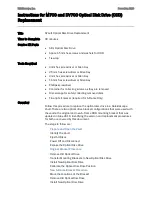
-o
Operation (always required) {refer to previous list}.
-r
Random Seed (wri) {0 - 65535}.
-s
Source Address (mov, pos) {device-specific, determine range from Element Info}.
-t
Type of Parameter Value.
• (gpo) {1=logical block, 2=physical block}.
• (spo) {1=logical block, 2=physical block}.
• (gpa) {1=block size, 2=compression, 3=buffering, 4=immediate, 5=trailer, 6=write protect, 7=acf
mode, 8=capacity, 9=sili}.
• (spa) {1=block size, 2=compression, 3=buffering, 4=immediate, 5=trailer, 6=write protect,
8=capacity, 9=sili}.
• (msg) {1=display msg0, 2=display msg1, 3=flash msg0, 4=flash msg1, 5=alternate
msg1/msg2
}.
-v
Verbose Mode (optional for all commands, stand-alone flag) {no value that is required, absence of flag
means quiet mode}.
-w
Open Mode (optional for all commands) {1=read/write, 2=read only (default), 3=write only,
4=append}.
-x
Parameter Value.
• (lck) {1=lock, 2=unlock}.
• (lod) {1=load, 2=unload}.
• (spo) {0 - 65535}.
• (spa) {0 - 65535}.
-y
Messages (msg) {message1,message2}.
-z
Input/Output file name.
• (sdp) {path and name of the file in which to store memory dump}.
• (dmc) {path and name of the microcode image file}.
• (wri) {path and name of the file that contains write data pattern}.
Note:
1. For read and write operations, the size of one buffer of data that is transferred during a single SCSI
read or write command is determined by the product of the Block Size value and the B Factor value.
The number of these buffers that are transferred is determined by Multiplier value. The actual total
number of bytes transferred is then (Block Size) x (Blocking Factor) x (Multiplier). If the device is set to
fixed block mode (block size not equal to zero), the product of Block Size and Blocking Factor must be a
multiple of the device block size setting.
2. For information on the Get Parameter (gpa) and Set Parameter (spa) operations, refer to the
STIOC_GET_PARM
and
STIOC_SET_PARM
ioctl commands that are described in the Programming
Reference.
Examples
The following examples help to demonstrate and clarify the command-line usage of the tapeutil program.
For all examples, substitute the actual value of the special file that is associated with the target device.
TAPEUTIL in HP-UX system environment 273
















































